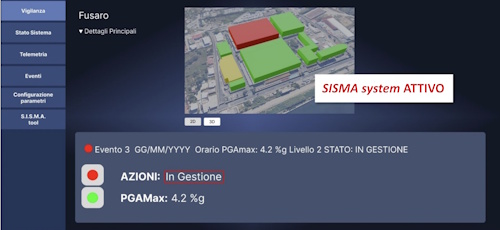A project developed by LGS with Italian universities and startups to ensure responsiveness, safety, and continuity of operations in areas with high seismic activity.
In a context such as that of the Phlegraean Fields, where over 6,700 seismic events were recorded in 2024 alone, Leonardo Global Solutions (LGS) has developed SISMA 2.0 (Structural Integrated Safety and Maintenance Assessment), an innovative anti-seismic monitoring system for emergency management. Tested in May 2025 at the Bacoli-Fusaro production site – a strategic asset of Leonardo's Electronics Division – SISMA 2.0 represents a new approach to seismic emergency management. It is not just about monitoring, but about making quick and informed decisions using an intelligent platform that combines scientific data, advanced sensors, and decision-making algorithms.
The initiative is the result of a collaboration between LGS, the Italian start-up BUILTI – specialising in the monitoring of critical infrastructure – and Prof. Marco Savoia of the University of Bologna, one of Italy's leading experts in structural and seismic engineering.

A system that makes decisions in under 2 minutes
Following a seismic event, SISMA 2.0 processes data in real time, assesses the recorded impact and classifies buildings based on potential structural damage, taking into account both the seismic performance of the buildings (IS-V) and the maximum ground acceleration (PGA max) recorded during the seismic event.
In under two minutes, the system automatically sends email and SMS alerts to site managers, specifying which buildings may have been affected and suggesting immediate actions in terms of structural checks and precautionary evacuations.
Soon, the algorithm will be developed further: the processed data will also be forwarded to structural engineers, who will receive detailed instructions on which inspections to carry out, saving considerable time and resources.

A real impact on wellbeing and safety
SISMA 2.0's value goes beyond technical efficiency. During testing in May, it had an immediate effect on the workplace atmosphere: a noticeable reduction in anxiety among employees, thanks to their access to clear, timely, shared information.
Via an internal communication system, all staff receive direct updates on post-event safety conditions. This approach promotes transparency, participation and a culture of preventive action, strengthening the bond of trust between individuals and the organisation.
A replicable model for critical territories and infrastructure
SISMA 2.0 is designed for the simultaneous management of multiple buildings and sites, making it applicable not only to industrial contexts, but also to strategic public infrastructure, service networks, complex buildings, and utilities in earthquake-prone areas.
The project has already attracted the interest of organisations involved in emergency management, which recognise its potential for civil protection and land management.
Innovation serving sustainability
SISMA 2.0 is a practical example of technology being applied to social responsibility and sustainability, thus contributing to Leonardo's ESG (Environmental, Social, Governance) goals:
- Environmental: optimises the efficacy of post-event inspections, reducing travel and indirect emissions.
- Social: improves safety, promotes psychological wellbeing and spreads a culture of prevention.
- Governance: ensures transparency, traceability and accountability in post-earthquake decisions.
A new response to complexity
By constantly monitoring the terrain, SISMA 2.0 will be able to respond quickly and accurately in the event of seismic events, minimising risks to people and infrastructure. Investing in innovative technologies shows how science, technology and operational synergies can transform a critical issue into an opportunity for prevention, resilience and innovation both for people and for business continuity.

